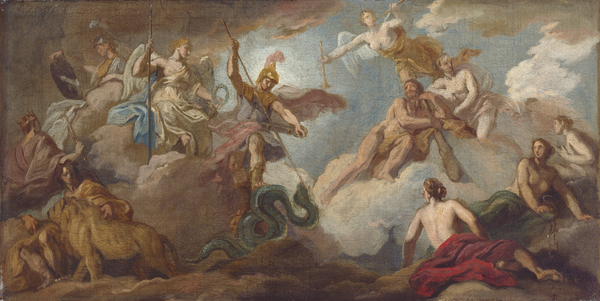Fortitude
Louis Chéron 2 Sep 1660 - 26 May 1725
Summary
This is a sketch for a ceiling design, one of a set of three in the collection of Manchester Art Gallery. The building for which the designs were made has not been identified, but it seems likely that there was once a fourth design, as each of Manchester’s three works probably represents one of the cardinal virtues. These are the fundamental good qualities identified from ancient Greek philosophy onwards as prudence, fortitude, temperance and justice. Temperance is Manchester’s missing virtue. Together with its two companions, this sketch had been thought of as being by James Thornhill (1635-1734) since 1964, when it was acquired by the gallery. This attribution was questionable, as the work displays none of the smooth pictorial qualities that characterised English decorative painting in Thornhill’s time. The new attribution was confirmed by an exhibition of Chéron's work curated by François Marandet at the Musée des Beaux Arts, Caen, in 2021-22. Previously called ‘The Victory of Apollo’, this sketch is now understood to show the virtue of Fortitude. The scene evokes the classical myth of Apollo fighting the serpent Python, while also bearing a strong resemblance to a description of ‘The Virtuous Act’ made by Cesare Ripa (about 1555 - probably 1628) in his influential book, Iconologia, first published in 1593. In the description, the virtuous act is conceived of as simultaneously lancing the head of a serpent while holding a book - as here. Behind the virtuous actor is the personification of Victory, offering him a laurel wreath. Behind Victory is perhaps Minerva, goddess of wisdom. It is mystifying as to why she turns away from the central scene and the lower figure is pictured from behind, especially as the latter appears to be royal, judging by the crown and sceptre. In the centre right is the figure of Hercules, easily recognisable from the massive club he holds. Behind Hercules may be his wife Hebe. Below this couple recline the three Graces. In them, Chéron’s distinctive style can be seen: they have a certain appearance of being modelled from wax. Louis Chéron was born in Paris in 1655. From 1678 he lived in Italy for six years, learning his craft initially at the French Academy in Rome. Following the repeal of the Edict of Nantes, which had protected Protestants in Catholic France, he left for England in 1693, where for thirty years he was a Huguenot at the centre of the London art scene. He taught drawing and copying in the style of the school of Rome at the art academy on Great Queen Street. Later, he became one of the founders of the art school known as the first St Martin’s Lane Academy, where William Hogarth (1697-1764) was a pupil. Very few easel paintings by Chéron now exist, as he concentrated on fine drawings and wall paintings. One of his impressive decorative schemes can still be seen at Boughton House in Northamptonshire.
Object Name
Fortitude
Creators Name
Date Created
1715-1725
Dimensions
unframed: 24.5cm x 48.5cm
framed: 36.2cm x 59.5cm
accession number
1964.59
Place of creation
England
Support
canvas
Medium
oil paint
Legal
© Manchester Art Gallery

